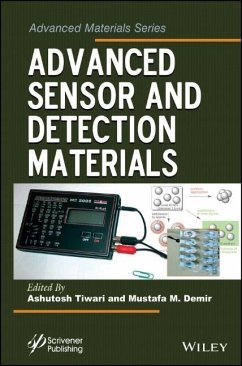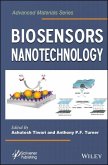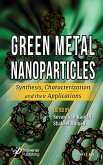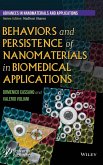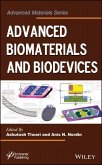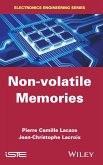Advanced Sensor and Detection Materials
Herausgegeben von Tiwari, Ashutosh; Demir, Mustafa M.
Advanced Sensor and Detection Materials
Herausgegeben von Tiwari, Ashutosh; Demir, Mustafa M.
- Gebundenes Buch
- Merkliste
- Auf die Merkliste
- Bewerten Bewerten
- Teilen
- Produkt teilen
- Produkterinnerung
- Produkterinnerung
Presents a comprehensive and interdisciplinary review of the major cutting-edge technology research areas-especially those on new materials and methods as well as advanced structures and properties-for various sensor and detection devices
The development of sensors and detectors at macroscopic or nanometric scale is the driving force stimulating research in sensing materials and technology for accurate detection in solid, liquid, or gas phases; contact or non-contact configurations; or multiple sensing. The emphasis on reduced-scale detection techniques requires the use of new materials and…mehr
Andere Kunden interessierten sich auch für
![Biosensors Nanotechnology Biosensors Nanotechnology]() Biosensors Nanotechnology227,99 €
Biosensors Nanotechnology227,99 €![Green Metal Nanoparticles Green Metal Nanoparticles]() Green Metal Nanoparticles290,99 €
Green Metal Nanoparticles290,99 €![Nanomaterials in Clinical Therapeutics Nanomaterials in Clinical Therapeutics]() Nanomaterials in Clinical Therapeutics250,99 €
Nanomaterials in Clinical Therapeutics250,99 €![Behaviors and Persistence of Nanomaterials in Biomedical Applications Behaviors and Persistence of Nanomaterials in Biomedical Applications]() Domenico CassanoBehaviors and Persistence of Nanomaterials in Biomedical Applications212,99 €
Domenico CassanoBehaviors and Persistence of Nanomaterials in Biomedical Applications212,99 €![Advanced Biomaterials and Biodevices Advanced Biomaterials and Biodevices]() Advanced Biomaterials and Biodevices227,99 €
Advanced Biomaterials and Biodevices227,99 €![Nanoparticulate Materials Nanoparticulate Materials]() K. LuNanoparticulate Materials187,99 €
K. LuNanoparticulate Materials187,99 €![Non-Volatile Memories Non-Volatile Memories]() Pierre-Camille LacazeNon-Volatile Memories179,99 €
Pierre-Camille LacazeNon-Volatile Memories179,99 €-
-
-
Presents a comprehensive and interdisciplinary review of the major cutting-edge technology research areas-especially those on new materials and methods as well as advanced structures and properties-for various sensor and detection devices
The development of sensors and detectors at macroscopic or nanometric scale is the driving force stimulating research in sensing materials and technology for accurate detection in solid, liquid, or gas phases; contact or non-contact configurations; or multiple sensing. The emphasis on reduced-scale detection techniques requires the use of new materials and methods. These techniques offer appealing perspectives given by spin crossover organic, inorganic, and composite materials that could be unique for sensor fabrication. The influence of the length, composition, and conformation structure of materials on their properties, and the possibility of adjusting sensing properties by doping or adding the side-groups, are indicative of the starting point of multifarious sensing. The role of intermolecular interactions, polymer and ordered phase formation, as well as behavior under pressure and magnetic and electric fields are also important facts for processing ultra-sensing materials.
The 15 chapters written by senior researchers in Advanced Sensor and Detection Materials cover all these subjects and key features under three foci: 1) principals and perspectives, 2) new materials and methods, and 3) advanced structures and properties for various sensor devices.
The development of sensors and detectors at macroscopic or nanometric scale is the driving force stimulating research in sensing materials and technology for accurate detection in solid, liquid, or gas phases; contact or non-contact configurations; or multiple sensing. The emphasis on reduced-scale detection techniques requires the use of new materials and methods. These techniques offer appealing perspectives given by spin crossover organic, inorganic, and composite materials that could be unique for sensor fabrication. The influence of the length, composition, and conformation structure of materials on their properties, and the possibility of adjusting sensing properties by doping or adding the side-groups, are indicative of the starting point of multifarious sensing. The role of intermolecular interactions, polymer and ordered phase formation, as well as behavior under pressure and magnetic and electric fields are also important facts for processing ultra-sensing materials.
The 15 chapters written by senior researchers in Advanced Sensor and Detection Materials cover all these subjects and key features under three foci: 1) principals and perspectives, 2) new materials and methods, and 3) advanced structures and properties for various sensor devices.
Produktdetails
- Produktdetails
- Advance Materials Series
- Verlag: Scrivener Publishing / Wiley & Sons
- Artikelnr. des Verlages: 1W118773480
- 1. Auflage
- Seitenzahl: 536
- Erscheinungstermin: 8. Juli 2014
- Englisch
- Abmessung: 243mm x 164mm x 32mm
- Gewicht: 869g
- ISBN-13: 9781118773482
- ISBN-10: 1118773489
- Artikelnr.: 40189327
- Advance Materials Series
- Verlag: Scrivener Publishing / Wiley & Sons
- Artikelnr. des Verlages: 1W118773480
- 1. Auflage
- Seitenzahl: 536
- Erscheinungstermin: 8. Juli 2014
- Englisch
- Abmessung: 243mm x 164mm x 32mm
- Gewicht: 869g
- ISBN-13: 9781118773482
- ISBN-10: 1118773489
- Artikelnr.: 40189327
Ashutosh Tiwari is an Associate Professor at the Biosensors and Bioelectronics Centre, Linköping University, Sweden; Editor-in-Chief, Advanced Materials Letters and Advanced Materials Reviews; Secretary General, International Association of Advanced Materials; a materials chemist and also a docent in applied physics at Linköping University, Sweden. He has published more than 350 articles, patents, and conference proceedings in the field of materials science and technology and has edited/authored about twenty books on the advanced state-of-the-art of materials science. He is a founding member of the Advanced Materials World Congress and the Indian Materials Congress. Mustafa M. Demir received his PhD degree from Sabancı University, Turkey, in 2004. From 2004 to 2007 he was a postdoctoral fellow at the Max Planck Institute of Polymer Research, Mainz, Germany. He then moved to Izmir Institute of Technology, Turkey, where he is now Chairman of the Department of Materials Science and Engineering.
Preface xv Part 1: Principals and Prospective 1 1 Advances in Sensors?
Nanotechnology 3 Ida Tiwari and Manorama Singh 1.1 Introduction 3 1.2 What
is Nanotechnology? 4 1.3 Significance of Nanotechnology 5 1.4 Synthesis of
Nanostructure 5 1.5 Advancements in Sensors' Research Based on
Nanotechnology 5 1.6 Use of Nanoparticles 7 1.7 Use of Nanowires and
Nanotubes 8 1.8 Use of Porous Silicon 11 1.9 Use of Self-Assembled
Nanostructures 12 1.10 Receptor-Ligand Nanoarrays 12 1.11 Characterization
of Nanostructures and Nanomaterials 13 1.12 Commercialization Efforts 14
1.13 Future Perspectives 14 References 15 2 Construction of Nanostructures:
A Basic Concept Synthesis and Their Applications 19 Rizwan Wahab, Farheen
Khan, Nagendra K. Kaushik, Javed Musarrat and Abdulaziz A.Al-Khedhairy 2.1
Introduction 20 2.2 Formation of Zinc Oxide Quantum Dots (ZnO-QDs) and
Their Applications 24 2.3 Needle-Shaped Zinc Oxide Nanostructures and Their
Growth Mechanism 30 2.4 Flower-Shaped Zinc Oxide Nanostructures and Their
Growth Mechanism 37 2.5 Construction of Mixed Shaped Zinc Oxide
Nanostructures and Their Growth Mechanicsm 47 2.6 Summary and Future
Directions 56 References 57 3 The Role of the Shape in the Design of New
Nanoparticles 61 G. Mayeli Estrada-Villegas and Emilio Bucio 3.1
Introduction 62 3.2 The Importance of Shape as Nanocarries 63 3.3 Influence
of Shape on Biological Process 65 3.4 Different Shapes of Polymeric
Nanoparticles 67 3.5 Different Shapes of Non-Polymeric Nanoparticles 71 3.6
Different Shapes of Polymeric Nanoparticles: Examples 74 3.7 Another Type
of Nanoparticles 76 Acknowledgments 80 References 80 4 Molecularly
Imprinted Polymer as Advanced Material for Development of Enantioselective
Sensing Devices 87 Mahavir Prasad Tiwari and Bhim Bali Prasad 4.1
Introduction 88 4.2 Molecularly Imprinted Chiral Polymers 90 4.3 MIP-Based
Chiral Sensing Devices 91 4.4 Conclusion 105 References 105 5 Role of
Microwave Sintering in the Preparation of Ferrites for High Frequency
Applications 111 S. Bharadwaj and S.R. Murthy 5.1 Microwaves in General 112
5.2 Microwave-Material Interactions 114 5.3 Microwave Sintering 115 5.4
Microwave Equipment 118 5.5 Kitchen Microwave Oven Basic Principle 122 5.6
Microwave Sintering of Ferrites 126 5.7 Microwave Sintering of Garnets 137
5.8 Microwave Sintering of Nanocomposites 138 References 140 Part 2: New
Materials and Methods 147 6 Mesoporous Silica: Making "Sense" of Sensors
149 Surender Duhan and Vijay K. Tomer 6.1 Introduction to Sensors 150 6.2
Fundamentals of Humidity Sensors 153 6.3 Types of Humidity Sensors 154 6.4
Humidity Sensing Materials 156 6.5 Issues with Traditional Materials in
Sensing Technology 158 6.6 Introduction to Mesoporous Silica 159 6.7 M41S
Materials 160 6.8 SBA Materials 162 6.9 Structure of SBA-15 164 6.10
Structure Directing Agents of SBA-15 165 6.11 Factors Affecting Structural
Properties and Morphology of SBA-15 169 6.12 Modification of Mesoporous
Silica 174 6.13 Characterization Techniques for Mesoporous Materials 177
6.14 Humidity Sensing of SBA-15 184 6.15 Extended Family of Mesoporous
Silica 185 6.16 Other Applications of SBA-15 188 6.17 Conclusion 190
References 191 7 Towards Improving the Functionalities of Porous TiO2-Au/Ag
Based Materials 193 Monica Baia, Virginia Danciu, Zsolt Pap and Lucian Baia
7.1 Porous Nanostructures Based on Tio2 and Au/Ag Nanoparticles for
Environmental Applications 194 7.2 Morphological Particularities of the
TiO2-based Aerogels 199 7.3 Designing the TiO2 Porous Nano-architectures
for Multiple Applications 201 7.4 Evaluating the Photocatalytic
Performances of the TiO2-Au/Ag Porous Nanocomposites for Destroying Water
Chemical Pollutants 208 7.5 Testing the Effectiveness of the TiO2-Au/Ag
Porous Nanocomposites for Sensing Water Chemical Pollutants by SERS 210 7.6
In-depth Investigations of the Most Efficient Multifunctional TiO2-Au/Ag
Porous Nanocomposites 216 7.7 Conclusions 221 Acknowledgments 223
References 223 8 Ferroelectric Glass-Ceramics 229 Viswanathan Kumar 8.1
Introduction 230 8.2 (Ba1-xSrx)TiO3 [BST] Glass-Ceramics 232 8.3
Glass-Ceramic System (1-y) BST: y (B2O3: x SiO2) 234 8.4 Glass-Ceramic
System (1-y) BST: y (BaO: Al2O3: 2SiO2) 245 8.5 Comparision of the Two BST
Glass-Ceramic Systems 254 8.6 Pb(ZrxTi1-x)TiO3[PZT] Glass-Ceramics 256
References 263 9 NASICON: Synthesis, Structure and Electrical
Characterization 265 Umaru Ahmadu 9.1 Introduction 265 9.2 Theretical
Survey of Superionic Conduction 268 9.3 NASICON Synthesis 271 9.4 NASICON
Structure and Properties 273 9.5 Characterization Techniques 278 9.6
Experimental Results 291 9.7 Problems, Applications, and Prospects 299 9.8
Conclusion 300 Acknowledgments 300 References 300 10 Ionic Liquids 309
Arnab De, Manika Dewan and Subho Mozumdar 10.1 Ionic Liquids: What Are
They? 309 10.2 Historical Background 310 10.3 Classification of Ionic
Liquids 311 10.4 Properties of Ionic Liquids, Physical and Chemical 314
10.5 Synthesis Methods of Ionic Liquids 323 10.6 Characterization of Ionic
Liquids 329 10.7 Major Applications of ILs 330 10.8 ILs in Organic
Transformations 331 10.9 ILs for Synthesis and Stabilization of Metal
Nanoparticles 339 10.10 Challenges with Ionic Liquids 344 References 346 11
Dendrimers and Hyperbranched Polymers 369 Jyotishmoy Borah and Niranjan
Karak 11.1 Introduction 369 11.2 Synthesis of Dendritic Polymers 372 11.3
Characterization 385 11.4 Properties 391 11.5 Applications 398 11.6
Conclusion 403 References 404 Part 3: Advanced Structures and Properties
413 12 Theoretical Investigation of Superconducting State Parameters of
Bulk Metallic Glasses 415 Aditya M. Vora 12.1 Introduction 415 12.2
Computational Methodology 417 12.3 Results and Discussion 421 12.4
Conclusions 434 References 434 13 Macroscopic Polarization and Thermal
Conductivity of Binary Wurtzite Nitrides 439 Bijaya Kumar Sahoo 13.1
Introduction 440 13.2 The Macroscopic Polarization 441 13.3 Effective
Elastic Constant, C44 442 13.4 Group Velocity of Phonons 443 13.5 Phonon
Scattering Rates 444 13.6 Thermal Conductivity of InN 445 13.7 Summary 449
References 450 14 Experimental and Theoretical Background to Study
Materials 453 Arnab De, Manika Dewan and Subho Mozumdar 14.1 Quasi-Elastic
Light Scattering (Photon Correlation Spectroscopy) 453 14.2 Transmission
Electron Microscopy (TEM) 456 14.3 Scanning Electron Microscopy [2] 457
14.4 X-ray Diffraction (XRD) 459 14.5 UV-visible Spectroscopy 461 14.6
FT-IR Spectroscopy 462 14.7 NMR Spectroscopy 463 14.8 Mass Spectrometry 464
14.9 Vibrating Sample Magnetometer 465 References 466 15 Graphene and Its
Nanocomposites for Gas Sensing Applications 467 Parveen Saini, Tapas Kuila,
Sanjit Saha and Naresh Chandra Murmu 15.1 Introduction 468 15.2 Principles
of Chemical Sensing by Conducting Nanocomposite Materials 470 15.3
Synthesis of Graphene and Its Nanocomposites 472 15.4 Characterization of
Graphene and Its Nanocomposites 473 15.5 Chemical Sensing of Graphene and
Its Nanocomposites 477 15.6 Conclusion and Future Aspects 493
Acknowledgements 494 References 494 Index 501
Nanotechnology 3 Ida Tiwari and Manorama Singh 1.1 Introduction 3 1.2 What
is Nanotechnology? 4 1.3 Significance of Nanotechnology 5 1.4 Synthesis of
Nanostructure 5 1.5 Advancements in Sensors' Research Based on
Nanotechnology 5 1.6 Use of Nanoparticles 7 1.7 Use of Nanowires and
Nanotubes 8 1.8 Use of Porous Silicon 11 1.9 Use of Self-Assembled
Nanostructures 12 1.10 Receptor-Ligand Nanoarrays 12 1.11 Characterization
of Nanostructures and Nanomaterials 13 1.12 Commercialization Efforts 14
1.13 Future Perspectives 14 References 15 2 Construction of Nanostructures:
A Basic Concept Synthesis and Their Applications 19 Rizwan Wahab, Farheen
Khan, Nagendra K. Kaushik, Javed Musarrat and Abdulaziz A.Al-Khedhairy 2.1
Introduction 20 2.2 Formation of Zinc Oxide Quantum Dots (ZnO-QDs) and
Their Applications 24 2.3 Needle-Shaped Zinc Oxide Nanostructures and Their
Growth Mechanism 30 2.4 Flower-Shaped Zinc Oxide Nanostructures and Their
Growth Mechanism 37 2.5 Construction of Mixed Shaped Zinc Oxide
Nanostructures and Their Growth Mechanicsm 47 2.6 Summary and Future
Directions 56 References 57 3 The Role of the Shape in the Design of New
Nanoparticles 61 G. Mayeli Estrada-Villegas and Emilio Bucio 3.1
Introduction 62 3.2 The Importance of Shape as Nanocarries 63 3.3 Influence
of Shape on Biological Process 65 3.4 Different Shapes of Polymeric
Nanoparticles 67 3.5 Different Shapes of Non-Polymeric Nanoparticles 71 3.6
Different Shapes of Polymeric Nanoparticles: Examples 74 3.7 Another Type
of Nanoparticles 76 Acknowledgments 80 References 80 4 Molecularly
Imprinted Polymer as Advanced Material for Development of Enantioselective
Sensing Devices 87 Mahavir Prasad Tiwari and Bhim Bali Prasad 4.1
Introduction 88 4.2 Molecularly Imprinted Chiral Polymers 90 4.3 MIP-Based
Chiral Sensing Devices 91 4.4 Conclusion 105 References 105 5 Role of
Microwave Sintering in the Preparation of Ferrites for High Frequency
Applications 111 S. Bharadwaj and S.R. Murthy 5.1 Microwaves in General 112
5.2 Microwave-Material Interactions 114 5.3 Microwave Sintering 115 5.4
Microwave Equipment 118 5.5 Kitchen Microwave Oven Basic Principle 122 5.6
Microwave Sintering of Ferrites 126 5.7 Microwave Sintering of Garnets 137
5.8 Microwave Sintering of Nanocomposites 138 References 140 Part 2: New
Materials and Methods 147 6 Mesoporous Silica: Making "Sense" of Sensors
149 Surender Duhan and Vijay K. Tomer 6.1 Introduction to Sensors 150 6.2
Fundamentals of Humidity Sensors 153 6.3 Types of Humidity Sensors 154 6.4
Humidity Sensing Materials 156 6.5 Issues with Traditional Materials in
Sensing Technology 158 6.6 Introduction to Mesoporous Silica 159 6.7 M41S
Materials 160 6.8 SBA Materials 162 6.9 Structure of SBA-15 164 6.10
Structure Directing Agents of SBA-15 165 6.11 Factors Affecting Structural
Properties and Morphology of SBA-15 169 6.12 Modification of Mesoporous
Silica 174 6.13 Characterization Techniques for Mesoporous Materials 177
6.14 Humidity Sensing of SBA-15 184 6.15 Extended Family of Mesoporous
Silica 185 6.16 Other Applications of SBA-15 188 6.17 Conclusion 190
References 191 7 Towards Improving the Functionalities of Porous TiO2-Au/Ag
Based Materials 193 Monica Baia, Virginia Danciu, Zsolt Pap and Lucian Baia
7.1 Porous Nanostructures Based on Tio2 and Au/Ag Nanoparticles for
Environmental Applications 194 7.2 Morphological Particularities of the
TiO2-based Aerogels 199 7.3 Designing the TiO2 Porous Nano-architectures
for Multiple Applications 201 7.4 Evaluating the Photocatalytic
Performances of the TiO2-Au/Ag Porous Nanocomposites for Destroying Water
Chemical Pollutants 208 7.5 Testing the Effectiveness of the TiO2-Au/Ag
Porous Nanocomposites for Sensing Water Chemical Pollutants by SERS 210 7.6
In-depth Investigations of the Most Efficient Multifunctional TiO2-Au/Ag
Porous Nanocomposites 216 7.7 Conclusions 221 Acknowledgments 223
References 223 8 Ferroelectric Glass-Ceramics 229 Viswanathan Kumar 8.1
Introduction 230 8.2 (Ba1-xSrx)TiO3 [BST] Glass-Ceramics 232 8.3
Glass-Ceramic System (1-y) BST: y (B2O3: x SiO2) 234 8.4 Glass-Ceramic
System (1-y) BST: y (BaO: Al2O3: 2SiO2) 245 8.5 Comparision of the Two BST
Glass-Ceramic Systems 254 8.6 Pb(ZrxTi1-x)TiO3[PZT] Glass-Ceramics 256
References 263 9 NASICON: Synthesis, Structure and Electrical
Characterization 265 Umaru Ahmadu 9.1 Introduction 265 9.2 Theretical
Survey of Superionic Conduction 268 9.3 NASICON Synthesis 271 9.4 NASICON
Structure and Properties 273 9.5 Characterization Techniques 278 9.6
Experimental Results 291 9.7 Problems, Applications, and Prospects 299 9.8
Conclusion 300 Acknowledgments 300 References 300 10 Ionic Liquids 309
Arnab De, Manika Dewan and Subho Mozumdar 10.1 Ionic Liquids: What Are
They? 309 10.2 Historical Background 310 10.3 Classification of Ionic
Liquids 311 10.4 Properties of Ionic Liquids, Physical and Chemical 314
10.5 Synthesis Methods of Ionic Liquids 323 10.6 Characterization of Ionic
Liquids 329 10.7 Major Applications of ILs 330 10.8 ILs in Organic
Transformations 331 10.9 ILs for Synthesis and Stabilization of Metal
Nanoparticles 339 10.10 Challenges with Ionic Liquids 344 References 346 11
Dendrimers and Hyperbranched Polymers 369 Jyotishmoy Borah and Niranjan
Karak 11.1 Introduction 369 11.2 Synthesis of Dendritic Polymers 372 11.3
Characterization 385 11.4 Properties 391 11.5 Applications 398 11.6
Conclusion 403 References 404 Part 3: Advanced Structures and Properties
413 12 Theoretical Investigation of Superconducting State Parameters of
Bulk Metallic Glasses 415 Aditya M. Vora 12.1 Introduction 415 12.2
Computational Methodology 417 12.3 Results and Discussion 421 12.4
Conclusions 434 References 434 13 Macroscopic Polarization and Thermal
Conductivity of Binary Wurtzite Nitrides 439 Bijaya Kumar Sahoo 13.1
Introduction 440 13.2 The Macroscopic Polarization 441 13.3 Effective
Elastic Constant, C44 442 13.4 Group Velocity of Phonons 443 13.5 Phonon
Scattering Rates 444 13.6 Thermal Conductivity of InN 445 13.7 Summary 449
References 450 14 Experimental and Theoretical Background to Study
Materials 453 Arnab De, Manika Dewan and Subho Mozumdar 14.1 Quasi-Elastic
Light Scattering (Photon Correlation Spectroscopy) 453 14.2 Transmission
Electron Microscopy (TEM) 456 14.3 Scanning Electron Microscopy [2] 457
14.4 X-ray Diffraction (XRD) 459 14.5 UV-visible Spectroscopy 461 14.6
FT-IR Spectroscopy 462 14.7 NMR Spectroscopy 463 14.8 Mass Spectrometry 464
14.9 Vibrating Sample Magnetometer 465 References 466 15 Graphene and Its
Nanocomposites for Gas Sensing Applications 467 Parveen Saini, Tapas Kuila,
Sanjit Saha and Naresh Chandra Murmu 15.1 Introduction 468 15.2 Principles
of Chemical Sensing by Conducting Nanocomposite Materials 470 15.3
Synthesis of Graphene and Its Nanocomposites 472 15.4 Characterization of
Graphene and Its Nanocomposites 473 15.5 Chemical Sensing of Graphene and
Its Nanocomposites 477 15.6 Conclusion and Future Aspects 493
Acknowledgements 494 References 494 Index 501
Preface xv Part 1: Principals and Prospective 1 1 Advances in Sensors?
Nanotechnology 3 Ida Tiwari and Manorama Singh 1.1 Introduction 3 1.2 What
is Nanotechnology? 4 1.3 Significance of Nanotechnology 5 1.4 Synthesis of
Nanostructure 5 1.5 Advancements in Sensors' Research Based on
Nanotechnology 5 1.6 Use of Nanoparticles 7 1.7 Use of Nanowires and
Nanotubes 8 1.8 Use of Porous Silicon 11 1.9 Use of Self-Assembled
Nanostructures 12 1.10 Receptor-Ligand Nanoarrays 12 1.11 Characterization
of Nanostructures and Nanomaterials 13 1.12 Commercialization Efforts 14
1.13 Future Perspectives 14 References 15 2 Construction of Nanostructures:
A Basic Concept Synthesis and Their Applications 19 Rizwan Wahab, Farheen
Khan, Nagendra K. Kaushik, Javed Musarrat and Abdulaziz A.Al-Khedhairy 2.1
Introduction 20 2.2 Formation of Zinc Oxide Quantum Dots (ZnO-QDs) and
Their Applications 24 2.3 Needle-Shaped Zinc Oxide Nanostructures and Their
Growth Mechanism 30 2.4 Flower-Shaped Zinc Oxide Nanostructures and Their
Growth Mechanism 37 2.5 Construction of Mixed Shaped Zinc Oxide
Nanostructures and Their Growth Mechanicsm 47 2.6 Summary and Future
Directions 56 References 57 3 The Role of the Shape in the Design of New
Nanoparticles 61 G. Mayeli Estrada-Villegas and Emilio Bucio 3.1
Introduction 62 3.2 The Importance of Shape as Nanocarries 63 3.3 Influence
of Shape on Biological Process 65 3.4 Different Shapes of Polymeric
Nanoparticles 67 3.5 Different Shapes of Non-Polymeric Nanoparticles 71 3.6
Different Shapes of Polymeric Nanoparticles: Examples 74 3.7 Another Type
of Nanoparticles 76 Acknowledgments 80 References 80 4 Molecularly
Imprinted Polymer as Advanced Material for Development of Enantioselective
Sensing Devices 87 Mahavir Prasad Tiwari and Bhim Bali Prasad 4.1
Introduction 88 4.2 Molecularly Imprinted Chiral Polymers 90 4.3 MIP-Based
Chiral Sensing Devices 91 4.4 Conclusion 105 References 105 5 Role of
Microwave Sintering in the Preparation of Ferrites for High Frequency
Applications 111 S. Bharadwaj and S.R. Murthy 5.1 Microwaves in General 112
5.2 Microwave-Material Interactions 114 5.3 Microwave Sintering 115 5.4
Microwave Equipment 118 5.5 Kitchen Microwave Oven Basic Principle 122 5.6
Microwave Sintering of Ferrites 126 5.7 Microwave Sintering of Garnets 137
5.8 Microwave Sintering of Nanocomposites 138 References 140 Part 2: New
Materials and Methods 147 6 Mesoporous Silica: Making "Sense" of Sensors
149 Surender Duhan and Vijay K. Tomer 6.1 Introduction to Sensors 150 6.2
Fundamentals of Humidity Sensors 153 6.3 Types of Humidity Sensors 154 6.4
Humidity Sensing Materials 156 6.5 Issues with Traditional Materials in
Sensing Technology 158 6.6 Introduction to Mesoporous Silica 159 6.7 M41S
Materials 160 6.8 SBA Materials 162 6.9 Structure of SBA-15 164 6.10
Structure Directing Agents of SBA-15 165 6.11 Factors Affecting Structural
Properties and Morphology of SBA-15 169 6.12 Modification of Mesoporous
Silica 174 6.13 Characterization Techniques for Mesoporous Materials 177
6.14 Humidity Sensing of SBA-15 184 6.15 Extended Family of Mesoporous
Silica 185 6.16 Other Applications of SBA-15 188 6.17 Conclusion 190
References 191 7 Towards Improving the Functionalities of Porous TiO2-Au/Ag
Based Materials 193 Monica Baia, Virginia Danciu, Zsolt Pap and Lucian Baia
7.1 Porous Nanostructures Based on Tio2 and Au/Ag Nanoparticles for
Environmental Applications 194 7.2 Morphological Particularities of the
TiO2-based Aerogels 199 7.3 Designing the TiO2 Porous Nano-architectures
for Multiple Applications 201 7.4 Evaluating the Photocatalytic
Performances of the TiO2-Au/Ag Porous Nanocomposites for Destroying Water
Chemical Pollutants 208 7.5 Testing the Effectiveness of the TiO2-Au/Ag
Porous Nanocomposites for Sensing Water Chemical Pollutants by SERS 210 7.6
In-depth Investigations of the Most Efficient Multifunctional TiO2-Au/Ag
Porous Nanocomposites 216 7.7 Conclusions 221 Acknowledgments 223
References 223 8 Ferroelectric Glass-Ceramics 229 Viswanathan Kumar 8.1
Introduction 230 8.2 (Ba1-xSrx)TiO3 [BST] Glass-Ceramics 232 8.3
Glass-Ceramic System (1-y) BST: y (B2O3: x SiO2) 234 8.4 Glass-Ceramic
System (1-y) BST: y (BaO: Al2O3: 2SiO2) 245 8.5 Comparision of the Two BST
Glass-Ceramic Systems 254 8.6 Pb(ZrxTi1-x)TiO3[PZT] Glass-Ceramics 256
References 263 9 NASICON: Synthesis, Structure and Electrical
Characterization 265 Umaru Ahmadu 9.1 Introduction 265 9.2 Theretical
Survey of Superionic Conduction 268 9.3 NASICON Synthesis 271 9.4 NASICON
Structure and Properties 273 9.5 Characterization Techniques 278 9.6
Experimental Results 291 9.7 Problems, Applications, and Prospects 299 9.8
Conclusion 300 Acknowledgments 300 References 300 10 Ionic Liquids 309
Arnab De, Manika Dewan and Subho Mozumdar 10.1 Ionic Liquids: What Are
They? 309 10.2 Historical Background 310 10.3 Classification of Ionic
Liquids 311 10.4 Properties of Ionic Liquids, Physical and Chemical 314
10.5 Synthesis Methods of Ionic Liquids 323 10.6 Characterization of Ionic
Liquids 329 10.7 Major Applications of ILs 330 10.8 ILs in Organic
Transformations 331 10.9 ILs for Synthesis and Stabilization of Metal
Nanoparticles 339 10.10 Challenges with Ionic Liquids 344 References 346 11
Dendrimers and Hyperbranched Polymers 369 Jyotishmoy Borah and Niranjan
Karak 11.1 Introduction 369 11.2 Synthesis of Dendritic Polymers 372 11.3
Characterization 385 11.4 Properties 391 11.5 Applications 398 11.6
Conclusion 403 References 404 Part 3: Advanced Structures and Properties
413 12 Theoretical Investigation of Superconducting State Parameters of
Bulk Metallic Glasses 415 Aditya M. Vora 12.1 Introduction 415 12.2
Computational Methodology 417 12.3 Results and Discussion 421 12.4
Conclusions 434 References 434 13 Macroscopic Polarization and Thermal
Conductivity of Binary Wurtzite Nitrides 439 Bijaya Kumar Sahoo 13.1
Introduction 440 13.2 The Macroscopic Polarization 441 13.3 Effective
Elastic Constant, C44 442 13.4 Group Velocity of Phonons 443 13.5 Phonon
Scattering Rates 444 13.6 Thermal Conductivity of InN 445 13.7 Summary 449
References 450 14 Experimental and Theoretical Background to Study
Materials 453 Arnab De, Manika Dewan and Subho Mozumdar 14.1 Quasi-Elastic
Light Scattering (Photon Correlation Spectroscopy) 453 14.2 Transmission
Electron Microscopy (TEM) 456 14.3 Scanning Electron Microscopy [2] 457
14.4 X-ray Diffraction (XRD) 459 14.5 UV-visible Spectroscopy 461 14.6
FT-IR Spectroscopy 462 14.7 NMR Spectroscopy 463 14.8 Mass Spectrometry 464
14.9 Vibrating Sample Magnetometer 465 References 466 15 Graphene and Its
Nanocomposites for Gas Sensing Applications 467 Parveen Saini, Tapas Kuila,
Sanjit Saha and Naresh Chandra Murmu 15.1 Introduction 468 15.2 Principles
of Chemical Sensing by Conducting Nanocomposite Materials 470 15.3
Synthesis of Graphene and Its Nanocomposites 472 15.4 Characterization of
Graphene and Its Nanocomposites 473 15.5 Chemical Sensing of Graphene and
Its Nanocomposites 477 15.6 Conclusion and Future Aspects 493
Acknowledgements 494 References 494 Index 501
Nanotechnology 3 Ida Tiwari and Manorama Singh 1.1 Introduction 3 1.2 What
is Nanotechnology? 4 1.3 Significance of Nanotechnology 5 1.4 Synthesis of
Nanostructure 5 1.5 Advancements in Sensors' Research Based on
Nanotechnology 5 1.6 Use of Nanoparticles 7 1.7 Use of Nanowires and
Nanotubes 8 1.8 Use of Porous Silicon 11 1.9 Use of Self-Assembled
Nanostructures 12 1.10 Receptor-Ligand Nanoarrays 12 1.11 Characterization
of Nanostructures and Nanomaterials 13 1.12 Commercialization Efforts 14
1.13 Future Perspectives 14 References 15 2 Construction of Nanostructures:
A Basic Concept Synthesis and Their Applications 19 Rizwan Wahab, Farheen
Khan, Nagendra K. Kaushik, Javed Musarrat and Abdulaziz A.Al-Khedhairy 2.1
Introduction 20 2.2 Formation of Zinc Oxide Quantum Dots (ZnO-QDs) and
Their Applications 24 2.3 Needle-Shaped Zinc Oxide Nanostructures and Their
Growth Mechanism 30 2.4 Flower-Shaped Zinc Oxide Nanostructures and Their
Growth Mechanism 37 2.5 Construction of Mixed Shaped Zinc Oxide
Nanostructures and Their Growth Mechanicsm 47 2.6 Summary and Future
Directions 56 References 57 3 The Role of the Shape in the Design of New
Nanoparticles 61 G. Mayeli Estrada-Villegas and Emilio Bucio 3.1
Introduction 62 3.2 The Importance of Shape as Nanocarries 63 3.3 Influence
of Shape on Biological Process 65 3.4 Different Shapes of Polymeric
Nanoparticles 67 3.5 Different Shapes of Non-Polymeric Nanoparticles 71 3.6
Different Shapes of Polymeric Nanoparticles: Examples 74 3.7 Another Type
of Nanoparticles 76 Acknowledgments 80 References 80 4 Molecularly
Imprinted Polymer as Advanced Material for Development of Enantioselective
Sensing Devices 87 Mahavir Prasad Tiwari and Bhim Bali Prasad 4.1
Introduction 88 4.2 Molecularly Imprinted Chiral Polymers 90 4.3 MIP-Based
Chiral Sensing Devices 91 4.4 Conclusion 105 References 105 5 Role of
Microwave Sintering in the Preparation of Ferrites for High Frequency
Applications 111 S. Bharadwaj and S.R. Murthy 5.1 Microwaves in General 112
5.2 Microwave-Material Interactions 114 5.3 Microwave Sintering 115 5.4
Microwave Equipment 118 5.5 Kitchen Microwave Oven Basic Principle 122 5.6
Microwave Sintering of Ferrites 126 5.7 Microwave Sintering of Garnets 137
5.8 Microwave Sintering of Nanocomposites 138 References 140 Part 2: New
Materials and Methods 147 6 Mesoporous Silica: Making "Sense" of Sensors
149 Surender Duhan and Vijay K. Tomer 6.1 Introduction to Sensors 150 6.2
Fundamentals of Humidity Sensors 153 6.3 Types of Humidity Sensors 154 6.4
Humidity Sensing Materials 156 6.5 Issues with Traditional Materials in
Sensing Technology 158 6.6 Introduction to Mesoporous Silica 159 6.7 M41S
Materials 160 6.8 SBA Materials 162 6.9 Structure of SBA-15 164 6.10
Structure Directing Agents of SBA-15 165 6.11 Factors Affecting Structural
Properties and Morphology of SBA-15 169 6.12 Modification of Mesoporous
Silica 174 6.13 Characterization Techniques for Mesoporous Materials 177
6.14 Humidity Sensing of SBA-15 184 6.15 Extended Family of Mesoporous
Silica 185 6.16 Other Applications of SBA-15 188 6.17 Conclusion 190
References 191 7 Towards Improving the Functionalities of Porous TiO2-Au/Ag
Based Materials 193 Monica Baia, Virginia Danciu, Zsolt Pap and Lucian Baia
7.1 Porous Nanostructures Based on Tio2 and Au/Ag Nanoparticles for
Environmental Applications 194 7.2 Morphological Particularities of the
TiO2-based Aerogels 199 7.3 Designing the TiO2 Porous Nano-architectures
for Multiple Applications 201 7.4 Evaluating the Photocatalytic
Performances of the TiO2-Au/Ag Porous Nanocomposites for Destroying Water
Chemical Pollutants 208 7.5 Testing the Effectiveness of the TiO2-Au/Ag
Porous Nanocomposites for Sensing Water Chemical Pollutants by SERS 210 7.6
In-depth Investigations of the Most Efficient Multifunctional TiO2-Au/Ag
Porous Nanocomposites 216 7.7 Conclusions 221 Acknowledgments 223
References 223 8 Ferroelectric Glass-Ceramics 229 Viswanathan Kumar 8.1
Introduction 230 8.2 (Ba1-xSrx)TiO3 [BST] Glass-Ceramics 232 8.3
Glass-Ceramic System (1-y) BST: y (B2O3: x SiO2) 234 8.4 Glass-Ceramic
System (1-y) BST: y (BaO: Al2O3: 2SiO2) 245 8.5 Comparision of the Two BST
Glass-Ceramic Systems 254 8.6 Pb(ZrxTi1-x)TiO3[PZT] Glass-Ceramics 256
References 263 9 NASICON: Synthesis, Structure and Electrical
Characterization 265 Umaru Ahmadu 9.1 Introduction 265 9.2 Theretical
Survey of Superionic Conduction 268 9.3 NASICON Synthesis 271 9.4 NASICON
Structure and Properties 273 9.5 Characterization Techniques 278 9.6
Experimental Results 291 9.7 Problems, Applications, and Prospects 299 9.8
Conclusion 300 Acknowledgments 300 References 300 10 Ionic Liquids 309
Arnab De, Manika Dewan and Subho Mozumdar 10.1 Ionic Liquids: What Are
They? 309 10.2 Historical Background 310 10.3 Classification of Ionic
Liquids 311 10.4 Properties of Ionic Liquids, Physical and Chemical 314
10.5 Synthesis Methods of Ionic Liquids 323 10.6 Characterization of Ionic
Liquids 329 10.7 Major Applications of ILs 330 10.8 ILs in Organic
Transformations 331 10.9 ILs for Synthesis and Stabilization of Metal
Nanoparticles 339 10.10 Challenges with Ionic Liquids 344 References 346 11
Dendrimers and Hyperbranched Polymers 369 Jyotishmoy Borah and Niranjan
Karak 11.1 Introduction 369 11.2 Synthesis of Dendritic Polymers 372 11.3
Characterization 385 11.4 Properties 391 11.5 Applications 398 11.6
Conclusion 403 References 404 Part 3: Advanced Structures and Properties
413 12 Theoretical Investigation of Superconducting State Parameters of
Bulk Metallic Glasses 415 Aditya M. Vora 12.1 Introduction 415 12.2
Computational Methodology 417 12.3 Results and Discussion 421 12.4
Conclusions 434 References 434 13 Macroscopic Polarization and Thermal
Conductivity of Binary Wurtzite Nitrides 439 Bijaya Kumar Sahoo 13.1
Introduction 440 13.2 The Macroscopic Polarization 441 13.3 Effective
Elastic Constant, C44 442 13.4 Group Velocity of Phonons 443 13.5 Phonon
Scattering Rates 444 13.6 Thermal Conductivity of InN 445 13.7 Summary 449
References 450 14 Experimental and Theoretical Background to Study
Materials 453 Arnab De, Manika Dewan and Subho Mozumdar 14.1 Quasi-Elastic
Light Scattering (Photon Correlation Spectroscopy) 453 14.2 Transmission
Electron Microscopy (TEM) 456 14.3 Scanning Electron Microscopy [2] 457
14.4 X-ray Diffraction (XRD) 459 14.5 UV-visible Spectroscopy 461 14.6
FT-IR Spectroscopy 462 14.7 NMR Spectroscopy 463 14.8 Mass Spectrometry 464
14.9 Vibrating Sample Magnetometer 465 References 466 15 Graphene and Its
Nanocomposites for Gas Sensing Applications 467 Parveen Saini, Tapas Kuila,
Sanjit Saha and Naresh Chandra Murmu 15.1 Introduction 468 15.2 Principles
of Chemical Sensing by Conducting Nanocomposite Materials 470 15.3
Synthesis of Graphene and Its Nanocomposites 472 15.4 Characterization of
Graphene and Its Nanocomposites 473 15.5 Chemical Sensing of Graphene and
Its Nanocomposites 477 15.6 Conclusion and Future Aspects 493
Acknowledgements 494 References 494 Index 501

